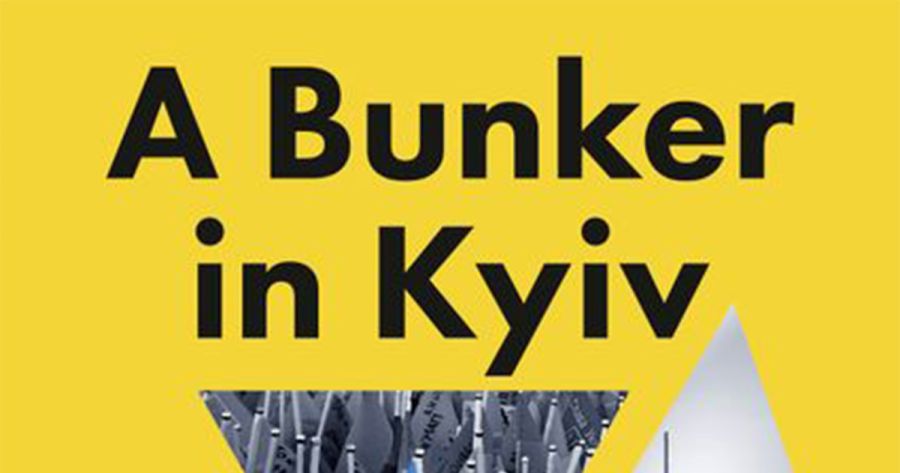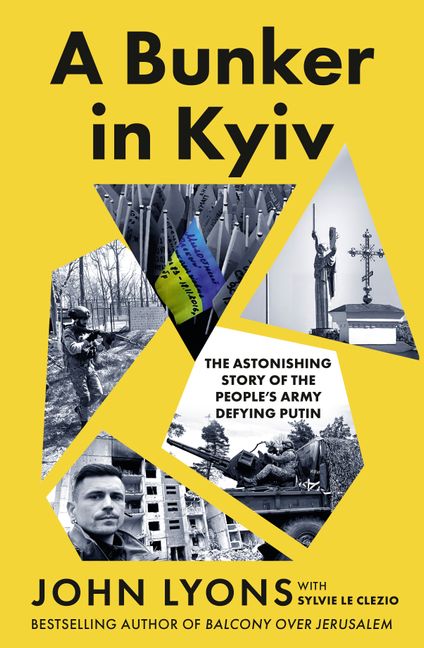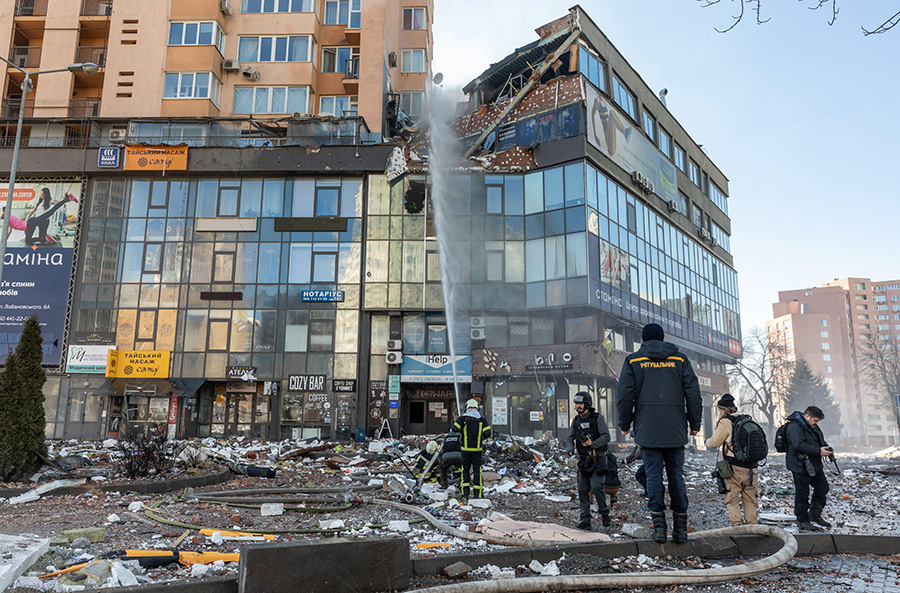
- Free Article: No
- Contents Category: Ukraine
- Review Article: Yes
- Article Title: Ukraine’s war as our war
- Article Subtitle: Australian reportage on a people in arms
- Online Only: No
- Custom Highlight Text:
Few people in Australia will disagree with John Lyons that the war in Ukraine is ‘morally unambiguous’ and that the Ukrainian people have right on their side. A Bunker in Kyiv tells how they have mobilised en masse, volunteering to serve not only on the battlefront and in defence production but also in support roles across the economic and social spectrum. As for their enemies, Ukrainians have come to view Russians solely as ‘invaders, not people’. For Lyons, the conflict is a simple one between good and evil, and his underlying message is that both morality and self-interest dictate that the international community should step up its support for Kyiv.
- Featured Image (400px * 250px):

- Alt Tag (Featured Image): Nick Hordern reviews ‘A Bunker in Kyiv: The astonishing story of the people’s army defying Putin’ by John Lyons with Sylvie Le Clezio
- Book 1 Title: A Bunker in Kyiv
- Book 1 Subtitle: The astonishing story of the people’s army defying Putin
- Book 1 Biblio: ABC Books, $34.99 pb, 311 pp
- Book 1 Cover Small (400 x 600):

- Book 1 Cover (800 x 1200):

- Book 1 Readings Link: https://www.readings.com.au/product/9780733343490/a-bunker-in-kyiv--john-lyons--2025--9780733343490#rac:jokjjzr6ly9m
An Australian perspective on the war in Ukraine is welcome. Lyons was until recently the ABC’s Global Affairs Editor (he became the ABC’s Americas Editor in May), and A Bunker in Kyiv is a work of reportage, a compilation of interviews conducted during three visits he made to Ukraine over a total period of two months. His focus is on what he says is the overlooked story of how a beleaguered Ukrainian population has transformed itself into ‘a people in arms’, while the latter part of the book moves down more well-trodden paths of military and geopolitical analysis.
Lyons introduces the reader to a portrait gallery of Ukrainians, many of them directly engaged in the war effort. For those in ordinary jobs in cities like Kyiv, remote from actual ground combat, just continuing to live and work under a hail of Russian drones and missiles is an act of resistance because it keeps normality alive. The stress of war has reminded Ukrainians and sympathetic observers that the mundane, the spontaneous, and the altruistic are all key elements of civic life.
The aim of Vladimir Putin’s invasion, as he himself described it in a notorious 2021 essay, is to restore the ‘historical unity’ of the two countries. Lyons tells us that the conflict has had the opposite result: outside occupied territory, the formerly widely spoken Russian language is losing its currency as Ukrainians refuse to use it. This is part of a movement, strongly backed by the government in Kyiv, to re-emphasise a distinct Ukrainian identity. (In September 2023, ABR reviewed Mikhail Zygar’s War and Punishment and Mark Edele’s Russia’s War Against Ukraine, both of which traced the evolution of this separate Ukrainian identity over a millennium.)
Wars usually speed up the evolution of tactics and technology, but this war has proved remarkable in this respect. Lyons discusses the way in which advances in cyber and drone warfare in Ukraine are revolutionising the future of conflict – which is why Australian self-interest is directly involved, whether Australians like it or not. Because Ukraine’s cyber defences have proved effective in defeating Russian attacks, countries like Australia have become targets both because they have supported Ukraine and more broadly because they offer technologically advanced targets for Russia to test its cyber warfare capabilities on.
 Kyiv, Ukraine, 2022 (Mykhailo Palinchak/Akamy)
Kyiv, Ukraine, 2022 (Mykhailo Palinchak/Akamy)
Lyons cites 2022’s Russian-origin hack of Australia’s Medibank as a cyber attack which combined blackmail with implicit political threat. The advent of ‘grey warfare’ – Russia’s campaign of sabotage attacks on infrastructure in Europe and in international waters – is another emerging threat which everyone, including Australians, must now take into account.
A decade ago, the term ‘drone warfare’ evoked images of large, unmanned aircraft firing long range missiles at buildings and vehicles. In no other field has the dramatic change wrought by the Ukraine conflict been more obvious; now those images are of bird-sized machines dropping explosives on top of terrified individuals. Drones dominate the battlefield, and Lyons’s interviews with Ukrainian civilian drone designers further his upbeat narrative of resilience and technological prowess, conjuring a picture of cool and savvy Ukrainian people power triumphing over Russian brute force. This impression, widely shared in the West, was reinforced by Ukraine’s stunning early June drone attack on strategic air bases across Russia.
A Bunker in Kyiv went to press as recently as February, but the situation in Ukraine is developing rapidly. Drone warfare has proved to be a see-saw battle between measure and counter-measure, and it is not clear which side currently has the upper hand on the frontline itself. Russia’s 2024 adoption of fibre-optic cable (FOC) technology to guide drones, which rendered them immune to electronic jamming, proved a game changer, to which is credited with Moscow’s successful repulse of the Ukrainian incursion into Russia’s Kursk region. Lyons does not mention either FOC or the Russian recapture of the Kursk salient, which was completed in early 2025.
Lyons’s judgement that ‘the long-term outcome of the war will be decided in Washington’ is a truism, but it is not clear how this truth will manifest itself. The incoming Trump administration vowed to broker – or impose – an immediate ceasefire; instead, American diplomacy has degenerated into incoherence. This means that, at the time of writing, the following key questions remain unanswered: will the United States withdraw its support for Kyiv – specifically, to the point where Ukraine can no longer defend itself? And, could Europe compensate for this withdrawal of US support?
Since Trump assumed office, Russia and Ukraine, both unwilling to be seen to flout Washington’s demands for a ceasefire, have engaged in inconclusive talks. As each eyes the prospect of their own military advantage, neither seems serious about wanting a negotiated outcome. As the former Ukrainian Foreign Minister Dymtro Kuleba said at the end of May, the war was ‘much more likely to continue than it is to stop’. If it does, and if the Americans cut off aid, what can be done to support Ukraine? Some alternatives are being floated. In March, France and Britain established a Coalition of the Willing, which Australia joined. Besides aiming to increase military aid to Kyiv, the initiative raised the possibility of sending foreign peacekeepers to Ukraine. In Berlin, the new centre-right Chancellor Friedrich Merz has promised to boost German support for Ukraine. A NATO summit set for late June may see these developments take more concrete form.
Both the tone and content of Lyons’s book reinforce the impression that Ukraine, however it is faring on the battlefield, is prevailing in the struggle to win over international opinion – at least in Australia and Europe. This is a good thing, but a reader of A Bunker in Kyiv might feel that they are missing something: nuance. Lyons acknowledges that corruption was endemic in pre-invasion Ukraine, though rarely mentions it. This is despite the fact that, for example, in 2023 President Volodymyr Zelensky sacked the country’s regional directors of recruitment amid claims that bribery to avoid military service was widespread: Kyiv continues to face a chronic shortage of soldiers. Acknowledgement that wartime Ukrainian society is not perfect, and that Kyiv’s military outlook remains dire, would have added depth to Lyons’s analysis.
Lyons also doesn’t discuss the Australian government’s contribution towards the defence of Ukraine, something of an absence in a book which addresses the Australian response to the war. Readers may have been interested to learn more about Canberra’s unconvincingly explained decision not to transfer the Australian Defence Force’s decommissioned Taipan helicopters to Ukraine. Lyons’s silence on the subject is curious because he emphasises that that Kyiv’s war is also our war: ‘A strong Ukraine is a strong Australia.’ A Bunker in Kyiv certainly makes the case for increasing support. It will be interesting to see how the second Albanese government goes about honouring its pledge to stand ‘with Ukraine ... for as long as it takes’ and particularly to to help ‘ensure Russia’s illegal and immoral actions are not rewarded through any peace process’.

Comments powered by CComment